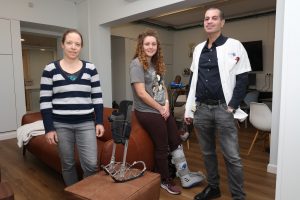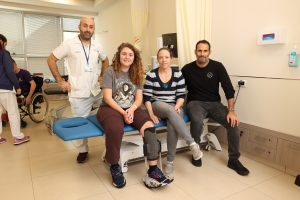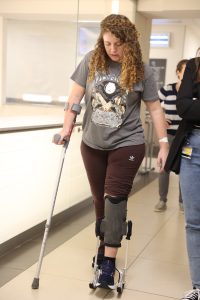Back on Her Feet
Neta Portal, a survivor of the terrorist attack in Kfar Aza, is learning to walk again with an orthotic device designed and built especially for her
On the morning of October 7th, Neta Portal and Santiago Perez woke up in their small apartment in Kfar Aza to the sound of warning sirens. They locked themselves in their safe room but were injured by the bullets that penetrated the door. When Santiago realized that the terrorists had thrown a grenade at the safe room door, he pushed Neta out of the window and followed her. While escaping from the apartment, they faced more gunfire from terrorists but managed to evade it and hide under one of the nearby buildings in the kibbutz. Santiago was hit in the back by a bullet, and Neta suffered seven gunshot wounds to her legs.
Both Neta and Santiago survived, injured but hidden, until they were rescued by Neta’s father, Deputy Chief Superintendent Shimon Portal. During her rehabilitation period at the Loewenstein Rehabilitation Medical Center, Neta received a unique orthotic device tailored especially for her. The device will help her to walk while her severely injured ankle is unable to bear weight. The device was developed at the Technion and tailored to Neta based on a three-dimensional scan of her leg. The personalized device was built thanks to a long-standing collaboration between Dr. Dana Solav from the Technion’s Faculty of Mechanical Engineering and Dr. Amir Haim from the Loewenstein Rehabilitation Medical Center. Both were doctoral students at the Technion under the guidance of Prof. Alon Wolf, currently dean of the Faculty of Mechanical Engineering, and have maintained a fruitful professional relationship ever since.
According to Dr. Solav, the purpose of the device is to enable the recovery of mobility while practicing natural and symmetrical walking under the requirement that the ankle is entirely or partially offloaded. The device effectively transfers weight to the healthy part of the leg above the injured part, allowing walking without causing pain. Moreover, it features an adjustment mechanism that facilitates a gradual and measured increase of weight-bearing of the affected part, according to the level permitted by the clinical condition.
Dr. Solav added that while walking with the device, the knee and hip joints can move and function normally, which helps prevent muscle atrophy and bone density reduction, especially in long-term rehabilitation processes. The three-dimensional scan eliminates the need for a plaster cast, and the computational design process facilitates the fabrication process, which combines a lightweight aluminum frame and 3D-printed parts.
Dr. Solav stated that in peacetime, injuries like Neta’s are uncommon. Unfortunately, in recent months, she has encountered other cases of soldiers with similar injuries. Sometimes, the injuries lead to amputation, but in many cases, doctors try to save the foot and ankle with complex surgeries, and the orthosis can improve the effectiveness of long-term rehabilitation after surgery. Additionally, they believe the orthosis can assist many diabetes patients who cannot walk due to pressure ulcers on the soles of their feet.
Dr. Solav’s research team, which consists of students and engineers, continues to develop and improve the orthosis while exploring its impact on walking. Simultaneously, the team is planning clinical trials in collaboration with Loewenstein Rehabilitation Medical Center, and hoping to see many people improve their walking rehabilitation by using the innovative orthosis in the near future.
Dr. Dana Solav, a faculty member in the Faculty of Mechanical Engineering at the Technion, completed her MSc and PhD under the guidance of Prof. Alon Wolf and Prof. Miles Rubin, and returned to the Technion as a faculty member after completing a post-doctorate at MIT. Her laboratory focuses on biomechanical interfaces, developing medical devices that connect to the body, such as prosthetics and braces, using 3D scans, medical imaging, and computer simulations.
Dr. Amir Haim is the director of the Biomechanical Rehabilitation Unit, the chairman of the Research Authority and a senior physician in the Department of Orthopedic Rehabilitation at the Loewenstein Rehabilitation Medical Center. He is a senior lecturer at the Faculty of Medicine at Tel Aviv University and an outstanding graduate of the combined MD/PhD track at the Technion – a track where participants complete a degree in medicine and a doctorate in philosophy.
This research is partially supported by the Henri Gutwirth Fund for the Promotion of Research.
In Dr. Solav’s laboratory there are other research projects, some of which are conducted in collaboration with the PTC company.





